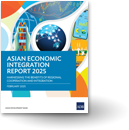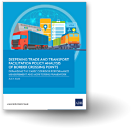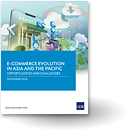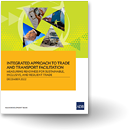Global value chains, trade policy and asia
The defining feature of early 21st-century international trade is global value chains (GVCs). Trade in GVCs is the fastest growing part of international trade, and a critical driver of productivity, growth and employment in both developed and developing countries. This is especially true in East Asia, where 62.5% of total manufacturing exports are GVC-related exports.
GVCs have transformed international trade in at least two major ways. First, exports depend more than ever on imports. In most economies, foreign value-added is about a third of the total value of exports—double what it was in 1990. It is 50% and higher in many small economies. Second, services are much more important than hitherto believed. Their share of gross exports of goods is about 30% on average—over 50% in the US and EU, and even 30% in the People’s Republic of China (PRC).
Four core policy propositions follow. First, GVCs reward open borders and non-discrimination to trade and foreign direct investment (FDI), secure private property rights, and an efficient environment for doing business. Second, they make nonsense of mercantilist trade policy—“exports good, imports bad”—given that exports depend increasingly on easy, open access to imported inputs. Third, they increase the range and power of producer interests favoring freer trade, all the better to countervail old-style protectionist interests. Fourth, they severely weaken the case for “industrial policy” in the form of selective protection for favored sectors and “national champions”. Such policies disrupt cross-border supply chains.
What are the main policy barriers to GVCs? Average import tariffs are now fairly low, but they impose higher costs on GVCs due to intermediate goods making multiple border crossings. Companies pay duty twice—once on imported inputs, and again on their exports.
Still, non-tariff barriers impose much higher costs. Complex, duplicative standards are especially burdensome for small and medium-sized enterprises. Protectionism in services sectors is much higher than on trade in goods. Then come FDI restrictions. Not least, onerous customs procedures cause delays at border entry and exit points. They account for about 10% of trade costs—double the cost of import duties.
Let’s turn to what this means for trade policy on different tracks.
Start with unilateral measures, i.e. what governments do autonomously, outside trade negotiations. This has been the main driver of trade and FDI liberalization outside the West in recent decades. Decentralized liberalization and competitive emulation, not trade agreements, are how East Asian countries opened up, inserted themselves into GVCs and became “Factory Asia”. But unilateral liberalization has slowed down since the late 1990s. That leads many to argue that reciprocity—trade negotiations—must be the main vehicle for future trade reforms.
I disagree. GVCs should make unilateral liberalization more feasible, given that more producer interests have a stake in open and freer trade. The Nike strategy should apply: “Just Do It!”—don’t wait for trade negotiations.
The World Trade Organization (WTO) can, however, be a useful complement to unilateral measures. The Doha Round is silent on 21st-century trade issues—save for one item, “trade facilitation”, which covers customs procedures. That should be the main priority for a mini-Doha package by the end of this year.
Looking beyond Doha, the WTO should tackle at least three items of relevance to GVCs: a more ambitious Information Technology Agreement; deeper commitments in services; and new rules on FDI. None of this is going to happen without “plurilateral” decision-making, whereby subsets of like-minded members from the Organisation for Economic Co-operation and Development (OECD) and emerging markets forge ahead. If that proves impossible inside the WTO, it should be taken outside it. The leading Asian trading powers should be in these “coalitions of the willing”. Indeed, they could constitute half or more of the membership of some of these coalitions.
That leaves Free Trade Agreements (FTAs). They discriminate against non-members, and their proliferation has created a “spaghetti bowl” of overlapping, bureaucratic trade procedures. This contradicts the basic logic of GVCs—to expand seamlessly across borders. Furthermore, the vast majority of FTAs, including most Asian FTAs, are “trade-light”. At best they eliminate tariffs on most products, but they hardly tackle the regulatory barriers that bedevil GVCs.
Now come three mega-regionals: Trans-Pacific Partnership (TPP), Transatlantic Trade and Investment Partnership (TITP) and the Regional Comprehensive Economic Partnership (RCEP). Trade-light mega-regionals would do little to facilitate GVCs, but their discriminatory elements could disrupt them. RCEP risks heading in this direction. “Deep-integration” mega-regionals, however, could spur GVCs by seriously tackling non-tariff and regulatory barriers, especially if rules are “multilateralized”, i.e. applied in a non-discriminatory manner. This is more likely with TPP and TITP than with RCEP, though they could easily turn in a defensive direction that disrupts GVCs.
Overall, there is huge potential for the spread of GVCs—sectorally in manufacturing, services, agriculture and energy, and geographically beyond the present hubs of the North American Free Trade Agreement (NAFTA), the EU and East Asia. The big geographic prize is the extension of GVCs to South Asia, where much labor-intensive manufacturing production could be located.




